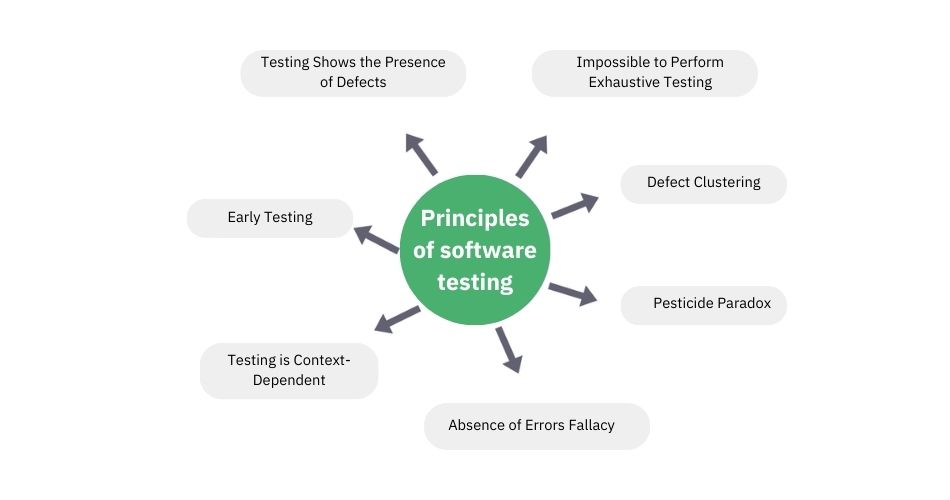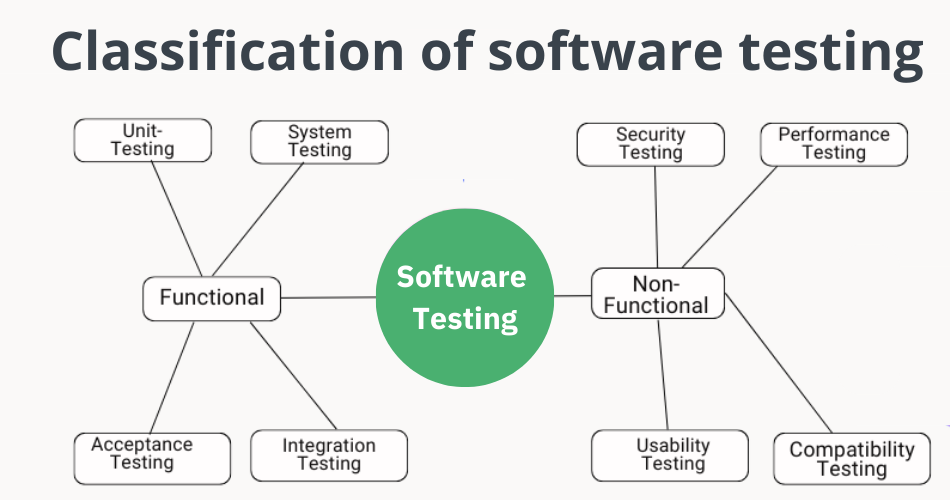Software development is a constantly changing field, and quality assurance is king. The quest for software solutions that seamlessly blend robust security measures with a user-friendly experience has become an indispensable requirement in our technologically advanced society. Therefore, we need to test various software modules to make the software bug-free and easier to use.
Software testing is a thorough procedure ensuring software programs satisfy the strictest functional and non-functional criteria. It evaluates every component and function of an application to uncover vulnerabilities and deficiencies.

Software testing allows developers to address any bugs before the product reaches end users. The implications of deploying incorrect software can be severe, involving monetary damages and user harm. Testing protects organizations and ends users from these dangers.
With so many software development testing types available, it’s critical to grasp their classification and the underlying value they bring to the table. It’s also essential for developers to understand the basic principles of software testing. These principles aim to provide a solid foundation of software testing to make reliable and efficient software.
This blog will explore the usefulness of different types of software testing methods. We will explore the testing classification as a framework for organizing and comprehending different types of testing approaches. Before diving in, let’s look at the principles of software testing.
Principles of Software Testing
Software testers follow seven fundamental principles to lead effective testing procedures. These principles provide a solid foundation for thorough and effective testing throughout the software development lifecycle. By adhering to these guidelines, businesses can reduce risks, improve software efficiency, and satisfy client demands. Let’s have a look at these principles.

1. Testing Shows the Presence of Defects
The primary objective of testing is to uncover the defects that software has. The principal testing shows the presence of faults. It emphasizes discovering the flaws rather than proving the absence of the defects. Let’s take an example of the online platform developed to check the plagiarism from files.
A test case is developed during testing to verify the functionality while submitting files. The test case works by uploading and submitting the file to the portal. However, testing reveals that the application cannot handle multiple language formats. The program explicitly allows various types that the system for rating does not recognize, which causes problems with feedback.
The testing procedure identified a weakness in the system’s conversion function. This emphasizes the significance of rigorous and extensive testing because it uncovers unforeseen flaws. It guarantees that the software’s performance and dependability are enhanced.
2. Impossible to Perform Exhaustive Testing
It is impossible to perform testing of each module to uncover defects. Testing all the modules will take more time and money because additional resources are needed. This would result in time and financial overruns. As a consequence, failure of the project will happen.
To overcome time and money constraints, the testing team should prioritize their efforts according to the requirements. They need to identify the most critical modules of the software by allocating more resources. Adopting this strategy will ensure critical flaws are noticed.
3. Early Testing
An essential principle in software testing is early testing. Early testing emphasizes the importance of performing testing procedures as soon as possible. It helps to find bugs earlier before it becomes a complex threat. Early testing enables prompt feedback, risk reduction, and iterative improvements. It led to more durable and dependable software solutions.
Consider a development team building an application for the financial institution. In light of early testing, the testers collaborate with the team to review the basic design and its requirements before the functional prototype. This will help to uncover the potential bugs or errors at the early stages saving time and resources.
4. Defect Clustering
According to defect clustering, most software flaws concentrate on specific system modules. It accords with the Pareto Principle, according to which just 20% of causes account for 80% of effects.
In the context of software testing, the testing procedures can be optimized to focus on high-risk modules. Defects should be adequately tracked and analyzed to help identify trends for improvements to the process. Software reliability and accuracy can be dramatically improved by tackling defect clustering.
5. Pesticide Paradox
The pesticide paradox draws attention to the fact that frequently using identical tests over time decreases the ability to find new flaws. The software may become resistant to existing test cases, much like how pests develop a resistance to a specific treatment.
Test cases should be frequently examined, updated, and adjusted to avoid the pesticide paradox. By updating the test suite, testers can find new flaws that may have gone unnoticed. This proactive strategy guarantees that the testing procedure stays efficient and flexible to the software’s developing nature.
6. Testing is Context-Dependent
Every project for software development is distinct, with a unique set of needs, limitations, and goals. Testing approaches should be tailored to the project’s specifics. Context-dependent testing acknowledges that there are many universal strategies for testing.
This principle highlights the necessity of aligning testing initiatives with various software factors. These factors may include the targeted audience, industry standards, software development methodology, and primary usage. Therefore, testing operations can be maximized by aligning with the project’s unique context.
7. Absence of Errors Fallacy
Testing every module with different user scenarios in software testing is difficult. There may be undetected flaws in the software even with complete testing. The absence of errors fallacy informs testers to rely on more than just user feedback for bug detection and removal. Instead, they must adopt a proactive approach to handling.
This includes completing rigorous testing across multiple scenarios, undertaking exploratory tests, and utilizing numerous testing approaches and tools to find undetected problems.
Static analysis and code reviews should be used with other quality assurance procedures to solve this fallacy. Better problem discovery and prevention are guaranteed by a thorough approach, raising the overall quality of software and client satisfaction.
Classification of Different Types of Testing
It entails categorizing testing approaches to create an organized framework for comprehending and using different types of software testing. Using this classification, one can choose the best testing strategy based on the software product’s objectives, specifications, and limitations. Let’s have a look at the category of software testing.

1. Functional Testing
Functional testing focuses on evaluating the behavior and functionality of the software application. It aims to confirm that the system functions as intended. It conforms with the declared functional specifications and end customer expectations.
Various methodologies are used during functional testing to assess the behavior of the software in different contexts. This entails creating test cases that account for multiple processes and user scenarios. The software outputs are analyzed by running those test scenarios. Any differences from the anticipated behavior are noted as faults.
Designing test scenarios that encompass both valid and incorrect inputs and address all applicable functional requirements is crucial. To simulate different scenarios, the test data needs to be meticulously collected. It should evaluate how the program responds to various data scenarios.
Testers can automate or interactively perform functional testing to streamline and enhance the testing process. These methods and resources ensure the application works properly and satisfies user needs.
2. Non-Functional Testing
Non-functional testing evaluates the application’s usability, performance, and other non-functional factors. Non-functional testing’s primary goal is ensuring the software meets both performance objectives and functional demands.
A functional application is only sufficient if it provides maximum efficiency. Non-functional testing ensures the program works well and meets user needs. It may include incorporating enhancements, improving system architecture, or improving procedures. These types of QA testing provide users with a fantastic experience, ensuring that the application satisfies their needs and runs well in real-world circumstances.
Functional Testing
1. Unit Testing
Before testing a whole software program, ensure each component works well. Unit testing verifies a unit’s function by guaranteeing that the inputs (which might range from one to a few) result in the expected output. This form of testing serves as a basis for more complicated apps with integration.
Separating the unit under test from its associated components is necessary for unit testing. This is frequently accomplished by substituting test doubles, such as stubs or mocks, for actual dependencies. The unit’s logic and behavior are only tested through isolation.
2. Integration Testing
Integration testing is similar to assembling puzzle pieces to determine if they fit precisely. Assume you have several components of a software framework, each of which works perfectly on its own. However, they may not work correctly when combined. That’s where integration testing comes in.
Integration testing works when these modules are tested simultaneously to ensure they work correctly. It occurs following unit testing but before the system testing. The purpose is to identify any flaws that may develop during the integration of the modules.
3. System Testing
Software testing incorporates system testing, which assesses the entire software system. It concentrates on confirming how the software system behaves and functions in its designed context. System testing is generally performed after integration testing.
System testing enables timely detection and mitigation of possible threats, mistakes, and failures. It contributes to the software product’s overall quality, which raises trust and client fulfillment levels. By performing system testing, organizations can have confidence in knowing the software is ready for deployment in real-world settings.
4. Acceptance Testing
Acceptance testing is the last stage of software testing. It determines whether a software system fulfills consumers’ or stakeholders’ needs and demands. It entails testing the program in a real-world environment to verify its readiness for distribution.
Users or stakeholders actively engage in the definition of test scenarios during acceptance testing. They develop test cases and run tests depending on their requirements.
There are two ways to perform acceptance testing. The first is alpha testing, where the users perform testing at the development site. The second method is beta testing, in which the program is provided to a dedicated user to test on their environments.
Acceptance testing can also be classified into user, business, contract, and operational testing. These types of QA testing can help organizations tailor their testing approach for different aspects of software acceptance.
Non-Functional Testing
1. Security Testing
Security testing is an essential component of non-functional testing. It determines how well a system secures data and discovers flaws. It examines if the system can avoid unauthorized access and mitigate security concerns.
Security testing involves running various security codes, penetration testing, and vulnerability assessment. It also determines whether authentication and authorization operate correctly. This type of testing ensures that confidential information remains safe and the system is secured from invasions and attacks by doing security tests.
2. Performance Testing
Performance testing focuses on determining a software system’s strength, flexibility, and efficiency. It entails how well the system operates under various workloads and circumstances.
Performance testing consists of several tests, such as load testing for assessing the system’s efficiency under average and high loads. Another is stress testing to push the system to its boundaries and scalability testing to evaluate its capacity to manage growing workloads. Organizations may improve the system’s functioning, ensuring it meets customer demands.
3. Usability Testing
Usability testing evaluates how much a software system is straightforward for its users. Real users participate in testing by completing certain activities while their responses are recorded.
It evaluates layout, routing, labeling, flexibility, and handling of bugs to guarantee a consistent user experience. It assures that the software fulfills its users’ needs and demands. This type of qa testing increases overall satisfaction and efficiency. Organizations can develop software by prioritizing usability testing and improving user adoption and performance.
4. Compatibility Testing
Compatibility testing ensures software works properly across multiple operating systems, web browsers, and smartphones. It looks for problems that may develop due to differences in operating systems, hardware combinations, and software editions.
By undertaking compatibility testing, organizations can find and fix problems that can develop due to platform differences. It guarantees an equivalent user experience and avoids layout or performance problems across various contexts. This allows you to reach a larger audience and eliminate compatibility issues.
Value of each type of testing
1. Unit Testing
- Minimize the time and resources needed for testing, bug fixing, and maintenance.
- Lowers regressions, increases overall stability, and finds issues early
- Encourages modular and loosely connected coding to make maintenance simpler
- Encourage team collaboration and act as documentation.
2. Integration Testing
- Draw attention to the interdependencies and possible conflicts between the linked modules.
- Examines how well the system works with other systems and how they interact.
- Prevents regressions when introducing new features or making modifications.
- Provides users with a seamless experience when utilizing various integrated features.
3. System testing
- Enables more precise validation of system behavior by constructing an atmosphere resembling real-world usage circumstances.
- Determines whether the system can scale effectively by assessing how well it can manage growing amounts of data, users, or transactions.
- It verifies the system’s resilience and durability by testing how well it can bounce back from mistakes, failures, or unanticipated occurrences.
4. Acceptance Testing
- It guarantees that users will readily accept and use the program, lowering their aversion to modification and facilitating a successful implementation.
- It verifies that the software satisfies the market’s needs and the fierce competition, establishing the company as a leader in the sector.
5. Security Testing
- Assist in the early detection and remediation of security concerns to prevent their exploitation.
- Eliminating weaknesses through testing may reduce security incidents’ potential economic and reputational effects.
- Assist businesses in adhering to their legal and regulatory data security and privacy duties.
6. Performance Testing
- Analyze and optimize utilization of resources, including CPU, memory, disc I/O, and network bandwidth.
- Assess its capacity to handle predicted user loads to ensure the system can manage peak usage scenarios without experiencing performance concerns.
- Response times are measured and analyzed during performance testing to ensure they are within allowable bounds and offer an intuitive and fast user interface.
7. Usability Testing
- It lowers the possibility of expensive development mistakes by validating different design choices.
- Make it easier to build iteratively and improve continuously depending on user feedback.
- Enhances user confidence and loyalty by providing a seamless and easy-to-use experience
- Strengthens accessibility initiatives by ensuring that items are usable by people of various capacities
8. Compatibility Testing
- Promote business expansion
- Distinguish from competitors
- Decreases the likelihood of technical difficulties, compatibility issues, and user irritation
- Reveals insights for improving adaptability, efficiency, and utilization of resources
Conclusion
Testing reveals the existence of faults, and complete testing could be more attainable. So, prioritizing efforts according to threats and objectives enables optimal resource allocation. The early inspection identifies and resolves errors before they become complicated.
At the same time, defect clustering allows for specific testing for increased software reliability. Preventing the pesticide paradox by modifying and updating test cases guarantees that pesticides remain effective.
Testing procedures should be context-specific and suited to the specific requirements of every project. It is critical to understand that software development testing types alone cannot ensure error-free software and that other quality assurance processes must be used.
Functional and non-functional testing provide distinct benefits in minimizing defects, assuring integration, verifying system behavior, fulfilling user expectations, strengthening security, optimizing performance, improving usability, and ensuring compatibility.
Businesses may create high-quality software that meets user needs, beats competitors, and promotes market success by adhering to these principles and implementing different software testing methodologies.





